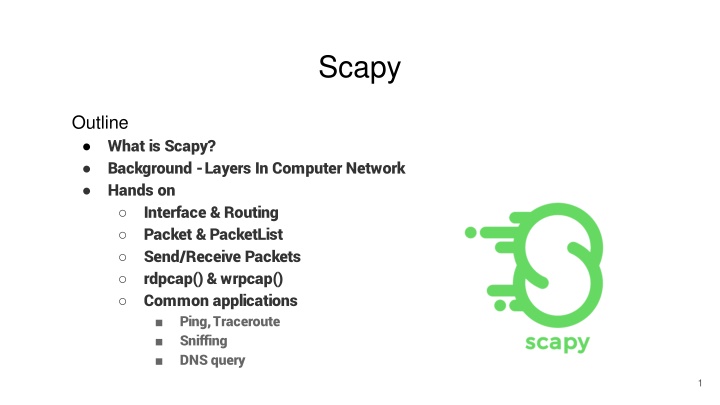
Explore Scapy: Interact with Network Layers, Hands-On Interface
"Discover Scapy, an interactive packet manipulation program for forging and decoding a wide range of protocols. Learn how to work with network interfaces, routing, and packet manipulation effortlessly. Dive into the world of computer networking layers with practical examples and applications."
Uploaded on | 1 Views
Download Presentation

Please find below an Image/Link to download the presentation.
The content on the website is provided AS IS for your information and personal use only. It may not be sold, licensed, or shared on other websites without obtaining consent from the author. If you encounter any issues during the download, it is possible that the publisher has removed the file from their server.
You are allowed to download the files provided on this website for personal or commercial use, subject to the condition that they are used lawfully. All files are the property of their respective owners.
The content on the website is provided AS IS for your information and personal use only. It may not be sold, licensed, or shared on other websites without obtaining consent from the author.
E N D
Presentation Transcript
Scapy Outline What is Scapy? Background -Layers In Computer Network Hands on Interface & Routing Packet & PacketList Send/Receive Packets rdpcap() & wrpcap() Common applications Ping, Traceroute Sniffing DNS query 1
What is Scapy? Interactive packet manipulation program. Forge or decode packets of a wide number of protocols. Without further ado, let's see Scapy in action! 2
Hands on - Interface & Routing In order to send packets through the network, Scapy should know the network configuration on your host machine. To see the interfaces running on your host, type: conf.ifaces Scapy has its own routing table, so that you can have your packets routed differently than the system. To see the routing table of Scapy, type: conf.route (for IPv4) or conf.route6 (for IPv6) 3
Background - Layers In Computer Network Computer networking is based on stacked protocol layers. Upper Layer Data Transport Layer Layer 4 Header Upper Layer Data Network Layer Layer 3 Header Upper Layer Data Data Link Layer Layer 2 Header Upper Layer Data 4
Hands on - Packet All you have to do is to stack the layers(protocols) needed, and fill in the parameters you want in the packet fields. Common classes of protocols in different layers: Application Layer HTTP(), DHCP(), DNS(), NTP(), SNMP() Transport Layer UDP(), TCP() Network Layer IP(), IPv6(), ICMP() Data Link Layer Ether() 5
Hands on - Packet Check the fields in protocols/packets. ls() Lists all the fields of specific protocol class, and shows each default value. show() show2() Returns a hierarchical view of the packet. show2() gives an assembled version. summary() Prints one line summary of a packet. hexdump() Displays the packet using classic hexdump format. 6
Hands on - Send/Receive Packets send() Send packets at layer 3. Parameters(optional): inter, loop, count, return_packets, iface, etc. sendp() Send packets at layer 2. Send and receive packets at layer 3. Parameters(optional): timeout, inter, retry, etc. sr() Send packets at layer 3 and return only the first answer. How to deal with multiple answers, let's see on the next page. sr1() 7
Hands on - SndRcvList & PacketList sr() will return two kinds of list SndRcvList: Stores the packets we sent and the corresponding responses. PacketList: If there is any packet that doesn't get the response, it would be placed here. 8 Figure from The Art of Packet Crafting with Scapy: Sending & recieving packets
Hands on - rdpcap() & wrpcap() rdpcap() Read packets from pcap file. wrpcap() Save capture packets to pcap file. 10
Hands on - Common applications Ping ICMP Echo Request srloop(IP(dst="163.22.22.61")/ICMP(),count=4) srloop() Send a packet at layer 3 in loop and print the answer each time. ARP Ping srp(Ether(dst="ff:ff:ff:ff:ff:ff")/ARP(pdst="10.22.149.0/24"), timeout=2) Scapy has built-in function for ARP Ping. arping() Performs similar to the above command. 11
Hands on - Common applications Traceroute ICMP ans, unans = sr(IP(dst="8.8.8.8", ttl=(1,10))/ICMP()) for snd,rcv in ans: print snd.ttl, rcv.src These tools use different protocols to traceroute: Program Protocol Used Unix traceroute UDP Windows tracert ICMP Scapy traceroute() TCP Scapy has built-in function for TCP traceroute. 12
Hands on - Common applications Sniff Scapy has built-in function for capturing traffic. Returns a PacketList of the captured packets. Parameters(optional): count, filter, iface, prn, timeout, etc. sniff() Sniff asynchronously. Allows to stop the sniffer programmatically, rather than with ctrl+C. Parameters(optional): The same as sniff(). Actions: start(), stop(), join(), results, etc. AsyncSniffer() 13
Hands on - Common applications DNS query What we need? Layers Classes Parameters Application Layer DNS(), DNSQR() DNS Question: QNAME, QTYPE. Transport Layer UDP() Messages sent using UDP port 53. Network Layer IP(), IPv6() DNS Server s IP address. 14
References Scapy s official website: https://scapy.net/ Scapy s GitHub: https://github.com/secdev/scapy Scapy s Documentation: https://scapy.readthedocs.io/en/latest/index.html Other learning materials I think are helpful: GeeksforGeeks Most of you must know this website. :) https://www.geeksforgeeks.org/scapy-packet-manipulation-in-kali-linux/?ref=gcse The Art of Packet Crafting with Scapy A note written by a workshop. https://0xbharath.github.io/art-of-packet-crafting-with-scapy/index.html thePacketGeek The author's name is Mat Wood. He also wrote a note for PyShark. https://thepacketgeek.com/scapy/ 15
